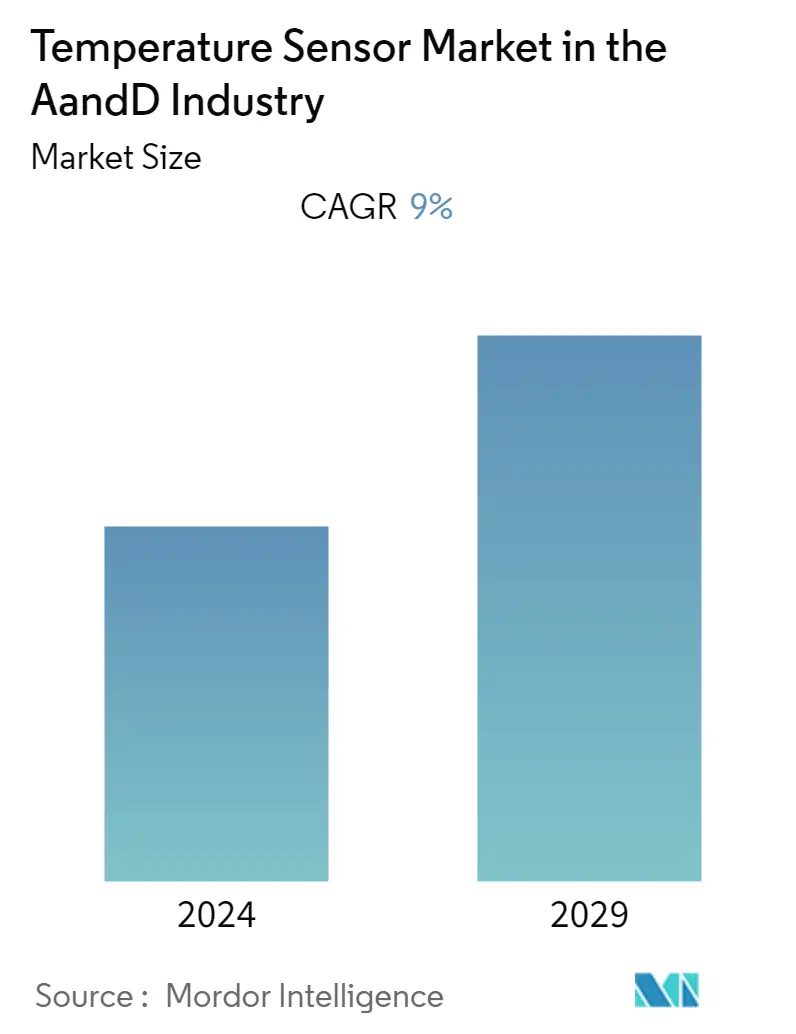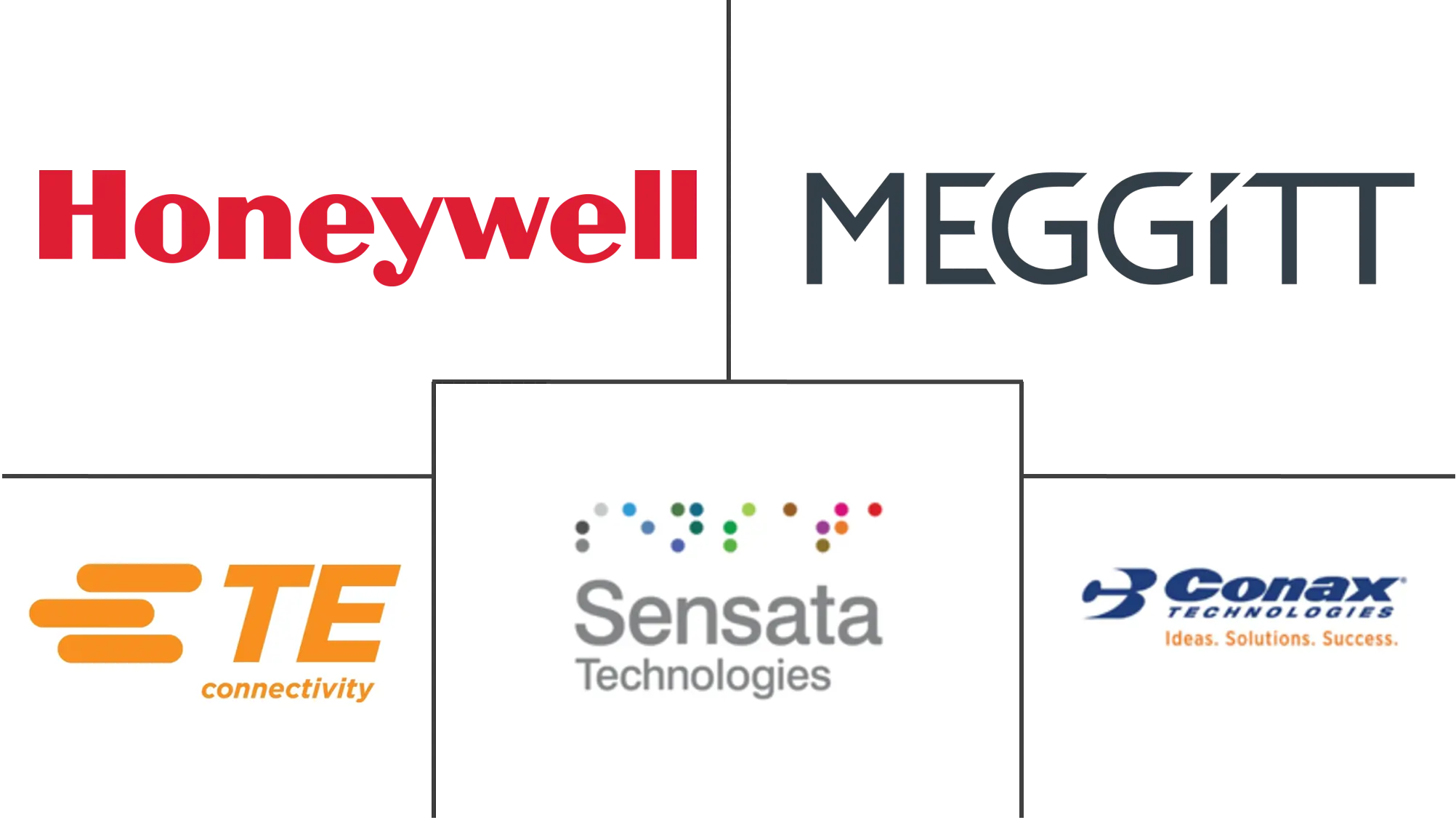Market Size of Temperature Sensor Industry in the A&D Industry

| Study Period | 2019 - 2029 |
| Base Year For Estimation | 2023 |
| CAGR | 9.00 % |
| Fastest Growing Market | Asia Pacific |
| Largest Market | North America |
| Market Concentration | Low |
Major Players
*Disclaimer: Major Players sorted in no particular order |
Aerospace & Defense Temperature Sensor Market Analysis
The Temperature Sensors Market in the Aerospace & Defense Industry is expected to register a CAGR of approximately 9% during the forecast period (2021 - 2026). The adoption of process and monitoring automation in the industrial operations have been augmenting the demand for sensors for several applications, such as asset monitoring, security, and quality assurance.
- Improved reliability of networked equipment with communication technology advancements is the significant factor driving the market for temperature sensors in the aerospace and defense industry. Substantial investments in the aerospace and defense industry to innovate and adopt new sensor technologies and the upgradation of existing infrastructure to support the adoption of IoT and automation in the industry are certain factors impacting the industry.
- In August 2019, CTS Corporation acquired the temperature sensor supplier Quality Thermistor, Inc. and broadened its product line. QTI Sensing Solutions supplies temperature sensors serving OEMs in the industrial, aerospace, defense, and medical markets. QTI's sensors measure temperature in gas, liquid, or a solid mass, depending on the application, to ensure equipment performance and reliability.
- In May 2020, India's state-owned Naval Dockyard in Mumbai developed a handheld infrared (IR)-based temperature gun sensor to screen a large number of people entering the dockyard daily to curb the spread of COVID-19 pandemic.
Aerospace & Defense Temperature Sensor Industry Segmentation
Temperature Sensors provide critical measurements for the aerospace and defense industry, such as temperature, pressure, humidity, speed, and fluid level for flight and engine control systems. These sensor solutions are useful for clean, efficient, reliable, and cost-effective engine operation under the toughest flight conditions. The scope of the study is limited to the study of the applications of temperature sensors in the aerospace and defense industry.
| Technology | |
| Thermocouple | |
| Infrared | |
| Integrated Circuit | |
| Thermistor | |
| RTD | |
| Other Technologies (Fiber Optic & Temperature Transmitter) |
| Geography | |
| North America | |
| Europe | |
| Asia Pacific | |
| Latin America | |
| Middle East and Africa |
Temperature Sensor Market in the A&D Industry Size Summary
The Temperature Sensor Market within the Aerospace and Defense Industry is experiencing significant growth, driven by the increasing adoption of automation and IoT technologies. The demand for temperature sensors is being fueled by the need for enhanced asset monitoring, security, and quality assurance. Advancements in communication technologies have improved the reliability of networked equipment, further propelling market growth. The industry's rapid digital transformation, characterized by the integration of portable electronic devices and embedded systems, has also contributed to the rising demand for temperature sensors. These sensors, particularly thermocouples, are favored for their robustness and reliability in harsh environments, making them ideal for aerospace and defense applications.
North America stands out as a key region for the temperature sensor market, supported by its critical infrastructure and the presence of numerous manufacturers and system integrators. The region's market growth is further bolstered by strategic partnerships and collaborations among major players like Honeywell, Meggitt PLC, and Sensata Technologies. The competitive landscape is fragmented, with several global companies vying for market share. Innovations such as FLIR Systems' Thermal Smart Sensor and the development of advanced sensor technologies by research institutions are expected to drive further adoption and integration of temperature sensors in the industry.
Temperature Sensor Market in the A&D Industry Market Size - Table of Contents
-
1. MARKET DYNAMICS
-
1.1 Market Overview
-
1.2 Key Sensor Trends (Low Power, Miniaturized Multi-Sensor Systems, Wireless Sensor Networks, Data Management and Integrated Sensor)
-
1.3 Market Drivers
-
1.4 Market Restraints
-
1.5 Industry Value Chain Analysis
-
1.6 Industry Attractiveness - Porter's Five Forces
-
1.6.1 Bargaining Power of Suppliers
-
1.6.2 Bargaining Power of Buyers/Consumers
-
1.6.3 Threat of New Entrants
-
1.6.4 Threat of Substitute Products
-
1.6.5 Intensity of Competitive Rivalry
-
-
1.7 Assessment of Impact of Covid-19 on the Industry
-
1.8 Key Applications of Temperature Sensors Across Various Type of Vehicles, Weapon Systems and Aircrafts
-
1.9 Wireless Technologies and Their Features - Cost, Security & Range (Bluetooth, WiFi, Zigbee, LORAWAN, NB-IoT)
-
-
2. MARKET SEGMENTATION
-
2.1 Technology
-
2.1.1 Thermocouple
-
2.1.2 Infrared
-
2.1.3 Integrated Circuit
-
2.1.4 Thermistor
-
2.1.5 RTD
-
2.1.6 Other Technologies (Fiber Optic & Temperature Transmitter)
-
-
2.2 Geography
-
2.2.1 North America
-
2.2.2 Europe
-
2.2.3 Asia Pacific
-
2.2.4 Latin America
-
2.2.5 Middle East and Africa
-
-
Temperature Sensor Market in the A&D Industry Market Size FAQs
What is the current Temperature Sensor Market in the A&D Industry size?
The Temperature Sensor Market in the A&D Industry is projected to register a CAGR of 9% during the forecast period (2024-2029)
Who are the key players in Temperature Sensor Market in the A&D Industry?
Honeywell International Inc., Meggitt PLC, Sensata Technologies Inc., TE Connectivity Ltd. and Conax Technologies are the major companies operating in the Temperature Sensor Market in the A&D Industry.

